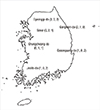Abstract
Figures and Tables
Fig. 1

Fig. 3

Fig. 4

Fig. 5

Fig. 6

Journal List > J Korean Med Sci > v.29(9) > 1022368





Sunghoon Park 
https://orcid.org/http://orcid.org/0000-0001-7004-6985
Sun Hwa Lee 
https://orcid.org/http://orcid.org/0000-0002-2002-0282
Ki-Hyun Seo 
https://orcid.org/http://orcid.org/0000-0002-0608-0676
Kyeong-Cheol Shin 
https://orcid.org/http://orcid.org/0000-0003-1972-1847
Kwang Ha Yoo 
https://orcid.org/http://orcid.org/0000-0001-9969-2657
Jae Seuk Park 
https://orcid.org/http://orcid.org/0000-0001-9307-1155
Jae Hwa Cho 
https://orcid.org/http://orcid.org/0000-0002-3432-3997
Yongchun Ko 
https://orcid.org/http://orcid.org/0000-0001-5635-8579
Soo-Keol Lee 
https://orcid.org/http://orcid.org/0000-0002-5608-9927
Do Il Kim 
https://orcid.org/http://orcid.org/0000-0001-9046-3970
Jun Wook Ha 
https://orcid.org/http://orcid.org/0000-0003-4967-2302
Jae-Myung Lee 
https://orcid.org/http://orcid.org/0000-0002-6241-6349
Ji-Won Suhr 
https://orcid.org/http://orcid.org/0000-0002-6649-9962
Ki-Suck Jung 
https://orcid.org/http://orcid.org/0000-0002-6878-6543